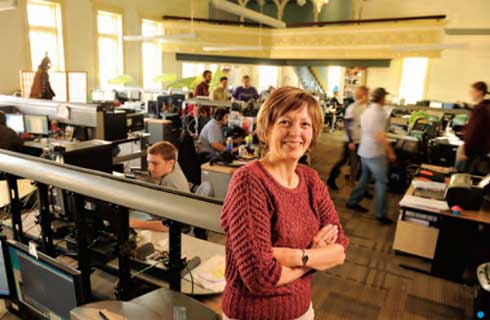Doctor of Philosophy in Chemical and Biological Engineering - Macroscale and Nanoscale Materials

学历文凭
Ph.D.

专业院系
化学工程

开学时间

课程时长

课程学费

国际学生入学条件
For admission to graduate study, an applicant must have a U.S. bachelor's degree or the equivalent of a U.S. bachelor's degree prior to enrollment.
Transcripts and Degrees must be in English (all post-secondary education, including transcript keys).
Unofficial transcripts should be uploaded to your graduate application. The minimum requirement for admission consideration is the completion and award of a four year U.S. bachelor's degree, or its equivalent, by the time of planned enrollment.
Personal Statement
Resume or curriculum vitae
Two letters of recommendation
Portfolio, if required by department
TOEFL score of 88 iBT
IELTS score of 6.5
Transcripts and Degrees must be in English (all post-secondary education, including transcript keys).
Unofficial transcripts should be uploaded to your graduate application. The minimum requirement for admission consideration is the completion and award of a four year U.S. bachelor's degree, or its equivalent, by the time of planned enrollment.
Personal Statement
Resume or curriculum vitae
Two letters of recommendation
Portfolio, if required by department
TOEFL score of 88 iBT
IELTS score of 6.5
IDP—雅思考试联合主办方

雅思考试总分
6.5
了解更多
- 雅思总分:6.5
- 托福网考总分:88
- 托福笔试总分:160
- 其他语言考试:Duolingo score of 120<br>PTE score of 59
CRICOS代码:
申请截止日期:请 与IDP联系 以获取详细信息。
课程简介
The Ph.D. degree represents the highest level of academic preparation. With it, a student can expect to maintain technical competence and contributions throughout a professional career. It is usually the preferred degree for research and development in industry and government and for teaching. Doctoral studies emphasize independent research under the guidance of a research advisor in a field related to Chemical and Biological Engineering, culminating in the writing of a thesis document and its defense in a presentation to the department and the thesis committee. Financial support typically comes from fellowships, research assistantships, teaching assistantships, or a combination.<br><br>Research interests center on developing and understanding the phenomena involved in producing and optimizing advanced materials for applications in optical, electronic, catalytic and allied industries. Thermodynamic, transport, and chemical processes governing the formation and subsequent behavior of these materials are under active investigation.<br><br>Also of interest is the self-assembly of macromolecules and nanoparticles to understand the structure and property relationships in hybrid nanoscale materials. Major interests are thermodynamics and kinetics in macromolecular self-assembly, materials synthesis, and structure characterizations. Novel experimental techniques reveal fundamental and important knowledge in macromolecular science and engineering.<br><br>Low dimensional quantum materials and their quantum effects hold promise for novel applications in electronic and optoelectronic devices. Some examples include graphene, transitional metal dichacogenides (TMDs, such as MoS2), and topological insulators. State-of-the-art nanofabrication techniques are applied to create structures and devices with control down to nanometer resolution. Optical spectroscopy measurement is used to characterize these nanoscale structures and devices by combining quantum transport (electrical) measurement with optical measurement.
相关申请

预科

奖学金

实习机会

在校学习

跨境学习

校园授课-线上开始

在线/远程学习
学校排名
世界排名
351
数据源:泰晤士高等教育世界大学排名
本校相关课程
电气工程学学士学位

学历文凭
Bachelor Degree
下一个开始日期
课程费用总额
Bachelor of Science in Interdisciplinary Science

学历文凭
Bachelor Degree
下一个开始日期
课程费用总额
Bachelor of Science in Physician-Scientist/Doctor of Medicine

学历文凭
Combined Bachelor's / Doctoral Degree
下一个开始日期
课程费用总额
技术商业化和创业学理学硕士

学历文凭
Masters Degree
下一个开始日期
课程费用总额
科学技术哲学博士

学历文凭
Ph.D.
下一个开始日期
课程费用总额
物理学哲学博士

学历文凭
Ph.D.
下一个开始日期
课程费用总额
其他相关课程
化学工程哲学博士-纳米技术

滑铁卢大学
泰晤士高等教育世界大学排名:

学历文凭
Ph.D.
下一个开始日期
课程费用总额
化学工程应用科学硕士-纳米技术

滑铁卢大学
泰晤士高等教育世界大学排名:

学历文凭
Masters Degree
下一个开始日期
课程费用总额
化学工程博士学位

滑铁卢大学
泰晤士高等教育世界大学排名:

学历文凭
Ph.D.
下一个开始日期
课程费用总额
化学工程学硕士

滑铁卢大学
泰晤士高等教育世界大学排名:

学历文凭
Masters Degree
下一个开始日期
课程费用总额
化学工程应用科学硕士

滑铁卢大学
泰晤士高等教育世界大学排名:

学历文凭
Masters Degree
下一个开始日期
课程费用总额
化学工程学士学位

滑铁卢大学
泰晤士高等教育世界大学排名:

学历文凭
Bachelor Degree
下一个开始日期
课程费用总额





